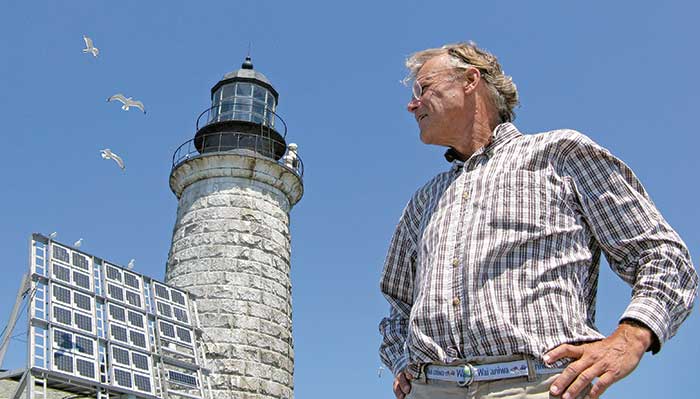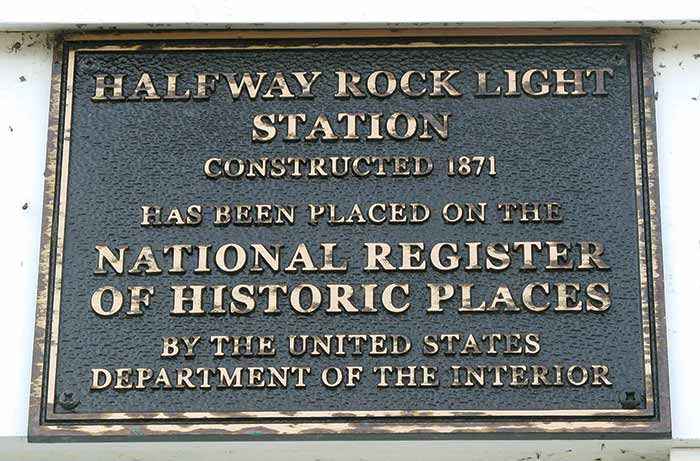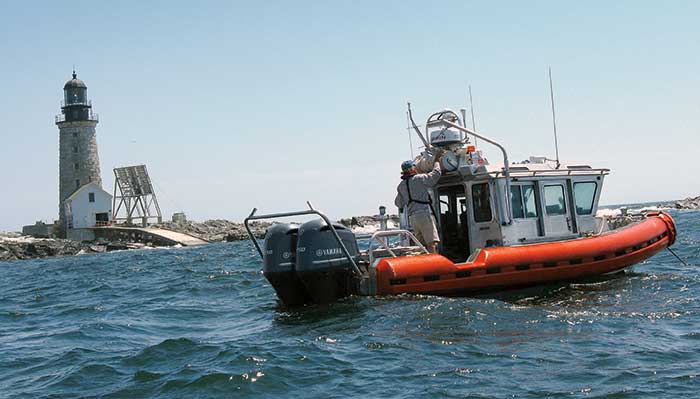Advertisement
Restoring the remote Halfway Rock Light Station in Maine's Casco Bay has been a labor of love for owner Ford Reiche.

About five years ago, Ford Reiche was cruising near shore in Maine's Casco Bay when he passed Halfway Rock Light Station. This is the most remote beacon in the bay, 4 miles from the nearest mainland and roughly halfway between Portland and Small Point. Perched on a treeless 2-acre ledge, the lighthouse is regularly swept by storm-driven waves.
From his boat, Reiche noticed that the abandoned light was in rough shape. Windows were boarded up, and siding was gone in the old keeper's house. The landing ramp was torn away. He wondered what would become of the maritime landmark, which preservationists had listed as one of the state's 10 most endangered properties.
Three years later, Reiche found himself the owner of Halfway Rock Light Station after buying it for $283,000 at government auction.
Advertisement
Today, Reiche is at the tail end of a complicated restoration project that has consumed much of his time and energy, has uncovered hidden elements of Halfway Rock's past, and is writing a new chapter in the history of the 146-year-old beacon. In a bay with 10-foot tides and fast-changing weather, early captains feared Halfway Rock. But the ledge, which rises only about 10 feet above a calm high tide, still managed to wreck ships and kill sailors until Congress authorized enough money to build a beacon in 1871. Granite blocks from nearby islands were quarried to erect a 76-foot tower.
Keepers lived in the tower and, later, in a two-story boathouse sheltered in the tower's lee. Stationed two at a time, they kept the light lit amid Maine's bone-chilling winters and storms during which 60-foot waves slammed into the structure. Because Halfway Rock was so barren and remote, it was operated as a "stag" lighthouse; families and spouses were banned, so the men assigned there also endured isolation.
Change came in 1939, when the U.S. Lighthouse Service was disbanded and folded into the U.S. Coast Guard. While Reiche and his work crew were tearing out a wall in the keepers' quarters, they found a whiskey bottle. Liquor, of course, was banned in the service, and this artifact of rebellion was signed and dated on New Year's Eve of 1938. The last crew left Halfway Rock in 1975. The light and foghorn were automated, but nothing else was maintained.

A marker on the lighthouse commemorates its listing on the National Register of Historic Places.
That's what caught the attention of Reiche as he motored past that day.
Retired after a career in transportation logistics, moving billions of pounds of material from rail to truck, Reiche had the skills and the passion to organize the rescue of a remote lighthouse. A trustee of Maine Preservation, the nonprofit state architectural preservation group, he'd restored historic homes and a railroad station. One of his first tasks at Halfway Rock was to figure out how to safely get back and forth to the rock from his marina in South Freeport, 10 miles away. The answer came at a Coast Guard auction, where he bought a used 25-foot SAFE Boats International Defender-class response boat. His military-grade monster, with its aluminum hull, rigid foam collar, and aluminum cabin, stands out in a marina of recreational Grady-Whites and Boston Whalers. If swamped, it will self-bail in a minute. Twin 250-hp Yamaha engines can launch the boat onto plane in 4 seconds. In dark or fog, a FLIR night-vision thermal camera makes navigation possible through waters strewn with lobster buoys and the occasional floating log.
"It's more performance than I or anyone really needs," Reiche says of his vessel. With its safety-orange collar system, Reiche commands attention when underway and says some boaters think he's some sort of marine patrol and quickly start counting life jackets. One day in thick fog, a powerboater flagged him down and asked for directions.
Reiche installed a mooring for the vessel off Halfway Rock. But getting from the mooring to the lighthouse is tricky, sometimes dangerous, and occasionally impossible. A ceaseless surge nips at the rock from all directions, along with swells that threaten to toss small boats into the landing ramp or adjacent ledges.
After destroying a couple of fiberglass and metal skiffs, Reiche settled on a 12-foot Avon inflatable with a 15-hp outboard. His technique for going ashore is to watch for a mild set of waves, gun the motor toward the wooden ramp with enough momentum to slide onto it, then yank up the engine and jump out.

Reiche's military-grade boat allows him to get back and forth to the lighthouse from his marina 10 miles away.
Even the Coast Guard has given up trying to get there by boat. Last summer, a maintenance crew showed up to service the light and foghorn, arriving via an HH-60 Jayhawk helicopter. The chopper lowered a three-man crew in a rescue basket. In the past year, Reiche and his helpers have built a 150-foot ramp, replaced all the windows, and restored the keepers' quarters to as it would have appeared in the 1950s, among other tasks.
Reiche had been doing his restoration in relative obscurity, until an article about the endeavor ran in the Portland newspaper. That led two former lighthouse keepers and a maintenance man who worked on the rock in the 1960s to contact him. From them, Reiche gained firsthand accounts and old photos that make the history come alive.
The men told him how they struggled to keep warm in winter and lived largely on TV dinners, how they got used to the roar of diesel generators running 24/7, and how a fuel ship at the mooring filled the diesel tanks twice a month with a 1,300-foot hose.
One former keeper shared a photo, taken after a storm washed away the dock in January 1963. It shows three men, one rowing a peapod, retrieving pieces of the wrecked dock amid snow-covered rocks. In the background, the 180-foot Lighthouse Tender Cowslip is seen at the mooring.
"It's absolutely thrilling for me," Reiche says. "When the men are gone, no one will know how to fully explain what's in the pictures. They've been able to look me in the eye and tell me about them."
Because it would be nearly impossible to have visitors to the lighthouse, Reiche plans to put all the information and images on a website. He's also setting up a webcam. That's the best way to share Halfway Rock, he said.
